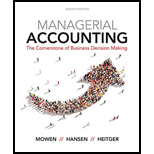
Managerial Accounting: The Cornerstone of Business Decision-Making
7th Edition
ISBN: 9781337115773
Author: Maryanne M. Mowen, Don R. Hansen, Dan L. Heitger
Publisher: Cengage Learning
expand_more
expand_more
format_list_bulleted
Question
Chapter 11, Problem 10MCQ
To determine
Identify minimum transfer price.
Expert Solution & Answer
Want to see the full answer?
Check out a sample textbook solution
Students have asked these similar questions
Can you solve this general accounting question with the appropriate accounting analysis techniques?
Can you solve this general accounting question with the appropriate accounting analysis techniques?
Please provide the accurate answer to this general accounting problem using valid techniques.
Chapter 11 Solutions
Managerial Accounting: The Cornerstone of Business Decision-Making
Ch. 11 - Discuss the differences between centralized and...Ch. 11 - Prob. 2DQCh. 11 - Explain why firms choose to decentralize.Ch. 11 - What are margin and turnover? Explain how these...Ch. 11 - What are the three benefits of ROI? Explain how...Ch. 11 - What is residual income? What is EVA? How does EVA...Ch. 11 - Can residual income or EVA ever be negative? What...Ch. 11 - What is transfer price?Ch. 11 - Prob. 9DQCh. 11 - (Appendix 11A) What is the Balanced Scorecard?
Ch. 11 - (Appendix 11A) Describe the four perspectives of...Ch. 11 - The practice of delegating authority to...Ch. 11 - Which of the following is not a reason for...Ch. 11 - A responsibility center in which a manager is...Ch. 11 - A responsibility center in which a manager is...Ch. 11 - If sales and average operating assets for Year 2...Ch. 11 - If sales and average operating assets for Year 2...Ch. 11 - The key difference between residual income and EVA...Ch. 11 - It ROI for a division is 15% and the company's...Ch. 11 - Prob. 9MCQCh. 11 - Prob. 10MCQCh. 11 - (Appendix 11A) Which of the following is a...Ch. 11 - (Appendix 11A) The length of time it takes to...Ch. 11 - Use the following information for Brief Exercises...Ch. 11 - Use the following information for Brief Exercises...Ch. 11 - Use the following information for Brief Exercises...Ch. 11 - Prob. 16BEACh. 11 - Use the following information for Brief Exercises...Ch. 11 - Use the following information for Brief Exercises...Ch. 11 - Use the following information for Brief Exercises...Ch. 11 - Use the following information for Brief Exercises...Ch. 11 - Prob. 21BEBCh. 11 - Calculating Transfer Price Teslum Inc. has a...Ch. 11 - Use the following information for Brief Exercises...Ch. 11 - Use the following information for Brief Exercises...Ch. 11 - Types of Responsibility Centers Consider each of...Ch. 11 - Margin, Turnover, Return on Investment Pelak...Ch. 11 - Margin, Turnover, Return on Investment, Average...Ch. 11 - Return on Investment, Margin, Turnover Data follow...Ch. 11 - Residual Income The Avila Division of Maldonado...Ch. 11 - Economic Value Added Falconer Company had net...Ch. 11 - Use the following information for Exercises 11-31...Ch. 11 - Use the following information for Exercises 11-31...Ch. 11 - Prob. 33ECh. 11 - Use the following information for Exercises 11-33...Ch. 11 - Prob. 35ECh. 11 - (Appendix 11A) Cycle Time and Velocity Prakesh...Ch. 11 - (Appendix 11A) Cycle Time and Velocity Lasker...Ch. 11 - (Appendix 11A) Manufacturing Cycle Efficiency...Ch. 11 - (Appendix 11A) Manufacturing Cycle Efficiency...Ch. 11 - Return on Investment and Investment Decisions...Ch. 11 - Return on Investment, Margin, Turnover Ready...Ch. 11 - Return on Investment for Multiple Investments,...Ch. 11 - Return on Investment and Economic Value Added...Ch. 11 - Transfer Pricing GreenWorld Inc. is a nursery...Ch. 11 - Prob. 45PCh. 11 - Prob. 46PCh. 11 - (Appendix 11A) Cycle Time, Velocity, Conversion...Ch. 11 - (Appendix 11A) Balanced Scorecard The following...Ch. 11 - (Appendix 11A) Cycle Time and Velocity,...Ch. 11 - Prob. 50C
Knowledge Booster
Similar questions
arrow_back_ios
SEE MORE QUESTIONS
arrow_forward_ios
Recommended textbooks for you
 Managerial Accounting: The Cornerstone of Busines...AccountingISBN:9781337115773Author:Maryanne M. Mowen, Don R. Hansen, Dan L. HeitgerPublisher:Cengage Learning
Managerial Accounting: The Cornerstone of Busines...AccountingISBN:9781337115773Author:Maryanne M. Mowen, Don R. Hansen, Dan L. HeitgerPublisher:Cengage Learning Essentials of Business Analytics (MindTap Course ...StatisticsISBN:9781305627734Author:Jeffrey D. Camm, James J. Cochran, Michael J. Fry, Jeffrey W. Ohlmann, David R. AndersonPublisher:Cengage Learning
Essentials of Business Analytics (MindTap Course ...StatisticsISBN:9781305627734Author:Jeffrey D. Camm, James J. Cochran, Michael J. Fry, Jeffrey W. Ohlmann, David R. AndersonPublisher:Cengage Learning Managerial AccountingAccountingISBN:9781337912020Author:Carl Warren, Ph.d. Cma William B. TaylerPublisher:South-Western College Pub
Managerial AccountingAccountingISBN:9781337912020Author:Carl Warren, Ph.d. Cma William B. TaylerPublisher:South-Western College Pub

Managerial Accounting: The Cornerstone of Busines...
Accounting
ISBN:9781337115773
Author:Maryanne M. Mowen, Don R. Hansen, Dan L. Heitger
Publisher:Cengage Learning

Essentials of Business Analytics (MindTap Course ...
Statistics
ISBN:9781305627734
Author:Jeffrey D. Camm, James J. Cochran, Michael J. Fry, Jeffrey W. Ohlmann, David R. Anderson
Publisher:Cengage Learning

Managerial Accounting
Accounting
ISBN:9781337912020
Author:Carl Warren, Ph.d. Cma William B. Tayler
Publisher:South-Western College Pub